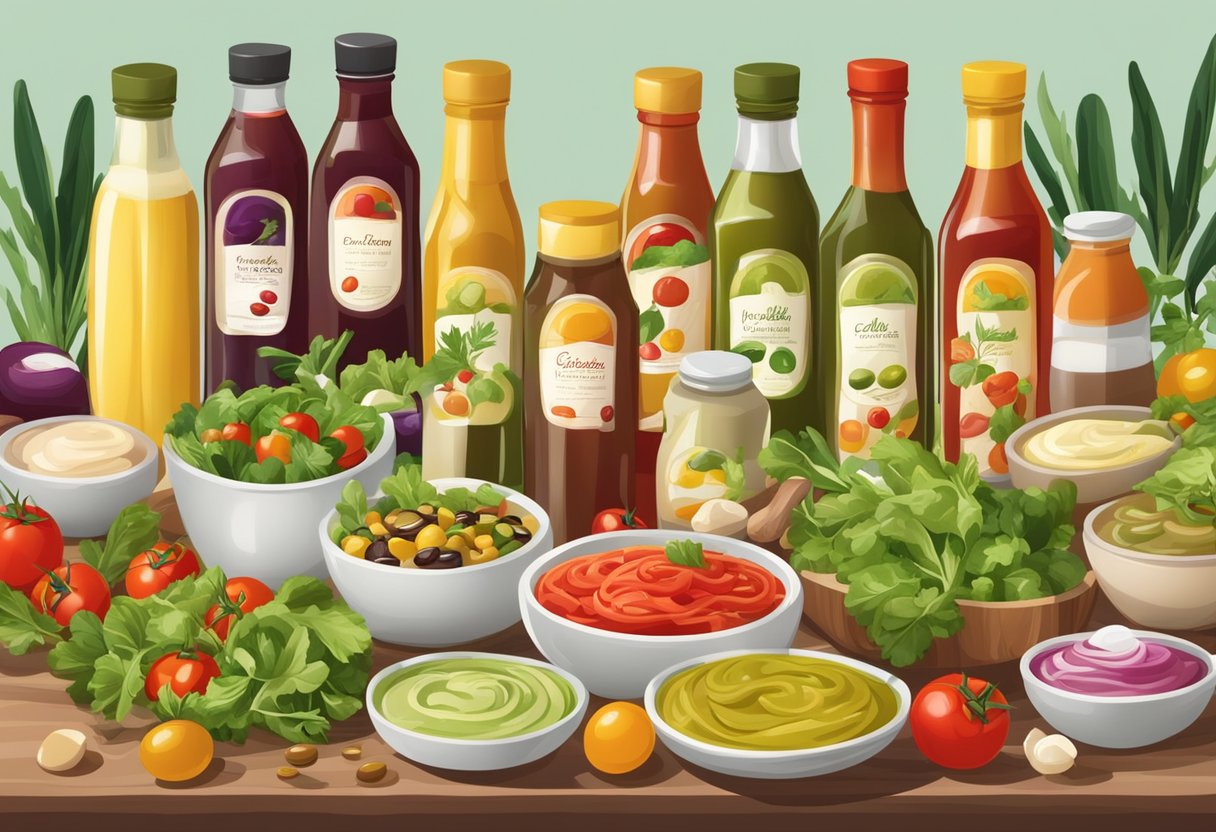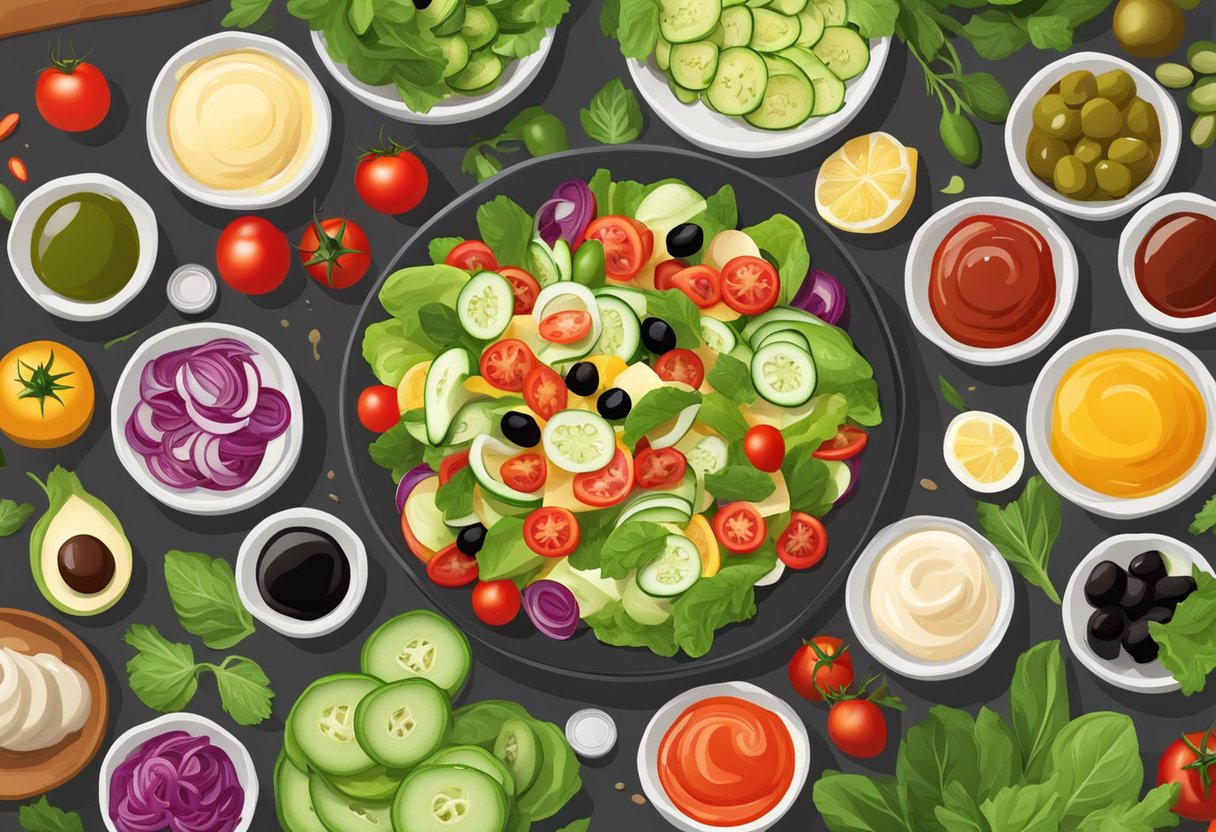Adopting a gluten-free Mediterranean diet merges the health benefits of traditional Mediterranean eating patterns with the necessary dietary modifications for those with celiac disease or gluten sensitivity. While this approach emphasizes fresh fruits, vegetables, legumes, and heart-healthy fats, individuals on this diet face unique challenges when it comes to commercially produced salad dressings and sauces. These products often contain gluten as a thickener or flavor enhancer and may not be suitable for a strict gluten-free regimen.

With the rising popularity of the Mediterranean diet, there is an increasing demand for compatible products that accommodate the requirements of a gluten-free lifestyle. However, the reality is that many store-bought dressings and sauces contain hidden sources of gluten, which can unintentionally lead to consumption of this protein. This necessitates a careful inspection of labels, an understanding of gluten-free certification, and, at times, the choice to create homemade alternatives using ingredients that align with both gluten-free and Mediterranean diet principles.
Key Takeaways
- A gluten-free Mediterranean diet is beneficial but requires vigilant screening of products like dressings and sauces.
- Hidden sources of gluten in commercial products demand thorough label reading and gluten-free certification for safe inclusion.
- Homemade dressings offer a safe alternative, aligning with the pillars of the Mediterranean diet and meeting gluten-free standards.
Table of Contents
Understanding Gluten-free
In the context of a gluten-free Mediterranean diet, it’s crucial to understand what gluten is, its impact on individuals with celiac disease, the advantages of a gluten-free diet, and the regulations pertaining to gluten-free labeling.
Defining Gluten and Celiac Disease
Gluten is a group of proteins found in wheat, barley, and rye. For individuals with celiac disease—a chronic autoimmune disorder—ingestion of gluten triggers an immune response that damages the small intestine. This reaction can cause various symptoms and prevent the absorption of vital nutrients.
Benefits of Gluten-free for Mediterranean Diets
Adopting a gluten-free approach within the Mediterranean diet can amplify its inherent health benefits, reducing inflammation and improving digestive health for those sensitive to gluten. This diet primarily consists of naturally gluten-free foods such as fruits, vegetables, legumes, nuts, seeds, fish, and olive oil.
Legislation and Gluten-free Labeling
Legislation requires that food labeled as “gluten-free” must contain fewer than 20 parts per million (ppm) of gluten. Certified gluten-free products undergo rigorous testing to prevent cross-contamination, assuring safety for individuals with celiac disease or gluten sensitivity.
Components of the Mediterranean Diet

The Mediterranean Diet encapsulates a diverse array of foods rich in nutrients and healthy fats, emphasizing gluten-free options that suit various dietary needs. This dietary pattern is renowned for its inclusion of an abundance of fresh produce and wholesome fats, presenting not only delectable flavors but also numerous health benefits.
Primary Foods and Nutrients
The foundation of a gluten-free Mediterranean diet is built on an assortment of vegetables and fruits, providing a spectrum of vitamins, minerals, and fiber. Legumes, such as beans, lentils, and chickpeas, are key protein sources that offer dietary fiber and essential nutrients. Nuts and seeds, including almonds and flaxseeds, are integrated as nutrient-dense snacks or garnishes.
Whole grains are an integral component; however, gluten-free options are readily available and include quinoa, buckwheat, and brown rice. Fish serves as the primary animal protein, revered for its omega-3 fatty acids. Moderate portions of dairy, in the form of cheese or yogurt, are customary but chosen carefully to accommodate a gluten-free diet.
Role of Healthy Fats
In the Mediterranean Diet, healthy fats are paramount, with olive oil standing as the centerpiece of fat consumption. It is favored for its monounsaturated fats and is often used as a salad dressing or cooking oil. The inclusion of olive oil in daily consumption is a characteristic feature of this diet, aiding in the absorption of fat-soluble vitamins and overall heart health.
Apart from olive oil, other sources of beneficial fats include nuts, seeds, and fatty fish, contributing to a reduced risk of chronic diseases. These fats are not only healthy but also add a richness to the culinary profile of the Mediterranean palette, enhancing flavors and textures while providing essential fatty acids.
Commercial Salad Dressings and Sauces

When choosing commercial salad dressings and sauces for a gluten-free Mediterranean diet, one must consider ingredients, gluten presence, and labeling to ensure compatibility with dietary needs.
Common Ingredients and Additives
Commercial salad dressings and sauces often contain a variety of ingredients and additives. These can include emulsifiers such as lecithin, thickeners like xanthan gum, and sweeteners, both artificial and natural. Additionally, preservatives are common to extend shelf life. Mediterranean diet-friendly options may include olive oil, lemon juice, and herbs like oregano and basil.
Identifying Gluten-free Options
To identify gluten-free options, consumers should look for dressings and sauces that are explicitly labeled as gluten-free. This ensures the product has been produced to avoid cross-contamination with gluten-containing ingredients. Gluten-free salad dressings might use thickeners like guar gum. Brands like Ken’s Foodservice offer a range of gluten-free dressings suitable for a Mediterranean diet.
Reading Labels and Ingredient Lists
Reading labels and ingredient lists is crucial for those following a gluten-free Mediterranean diet. Consumers should scrutinize labels for gluten-containing ingredients, such as wheat, barley, rye, and derivatives like malt. A thorough inspection of the ingredient list can also reveal the presence of Mediterranean diet-friendly ingredients such as extra virgin olive oil and vinegar, indicating a suitable choice for consumers.
Creating Your Own Gluten-free Dressings
Incorporating homemade gluten-free dressings into a Mediterranean diet is an excellent way to add flavor while maintaining dietary guidelines. These dressings often rely on simple combinations of olive oil, lemon juice, and various herbs for a fresh taste without the gluten.
Simple Gluten-free Dressing Recipes
Basic Vinaigrette:
To create a classic gluten-free vinaigrette, one simply needs three parts olive oil to one part vinegar. This ratio acts as a base for a variety of dressings suitable for the Mediterranean diet.
- Ingredients:
- 3 tablespoons olive oil
- 1 tablespoon vinegar (ensure gluten-free)
- Salt and pepper, to taste
- Optional: minced garlic or mustard for additional flavor
Herb-Infused Dressing:
For those seeking more complexity, adding fresh herbs like basil or oregano can elevate the profile of a simple dressing.
- Ingredients:
- 3 tablespoons olive oil
- 1 tablespoon lemon juice
- 1 teaspoon finely chopped fresh herbs
- Salt and pepper, to taste
One can find inspiration from brands like Organicville to create their own blends of gluten-free dressings that cater to the tastes of the Mediterranean palate.
Using Fresh Ingredients
The hallmark of a Mediterranean diet is the use of fresh, whole food ingredients. When crafting dressings, one should prioritize these for both flavor and health benefits.
Lemon Garlic Dressing:
By combining fresh lemon juice with minced garlic, diners can enjoy a zesty, gluten-free dressing that complements a variety of salads and vegetables.
- Ingredients:
- 3 tablespoons extra-virgin olive oil
- 1 tablespoon fresh lemon juice
- 1 clove garlic, minced
- Salt and pepper, to taste
Fresh Herb Dressing:
Utilizing a mix of fresh herbs can result in a vibrant, gluten-free dressing aligning with the Mediterranean emphasis on plant-based ingredients.
- Ingredients:
- 3 tablespoons extra-virgin olive oil
- 1 tablespoon white wine vinegar (ensure gluten-free)
- 2 teaspoons mixed fresh herbs (e.g., parsley, dill, mint)
- Salt and pepper, to taste
By selecting quality ingredients, such as organic olive oil and locally sourced herbs, individuals can create nutritious and delicious dressings that are both gluten-free and Mediterranean diet-friendly.
Health Considerations in Dressings

When selecting commercial salad dressings and sauces for a gluten-free Mediterranean diet, it’s crucial to consider their sugar and sodium content as well as the types and amount of fats and calories they contain. These factors can significantly impact the overall healthfulness of a meal.
Reducing Sugar and Sodium
- Sugar: Dressings can be a hidden source of added sugar. For instance, certain brands of gluten-free salad dressings may contain high levels of sugar to enhance flavor. It’s recommended to look for dressings with less than 5 grams of sugar per serving to maintain a healthy balance.
- Sodium: The sodium content in commercial dressings can be surprisingly high. A healthy choice would be dressings with less than 140 milligrams of sodium per serving. This helps in managing blood pressure and supports cardiovascular health, which is in line with the heart-friendly principles of the Mediterranean diet.
Understanding Fats and Calories
- Fats: Not all fats are created equal. Dressings on a gluten-free Mediterranean diet should favor unsaturated fats, such as olive oil, while minimizing saturated fats. Some gluten-free brands focus on healthier fat choices, aligning with the diet’s emphasis on heart health.
- Calories: Caloric content can vary widely among dressings. For those managing weight or requiring caloric control, opt for dressings that offer less than 120 calories per serving. Lower-calorie dressings complement the natural, nutrient-dense foods typical of the Mediterranean diet without adding excessive energy intake.
Adapting Dressings to Dietary Needs

When adhering to a gluten-free Mediterranean diet, it is essential to modify commercial salad dressings and sauces to meet dietary needs without sacrificing flavor or nutrition. Individuals must carefully choose ingredients that align with vegan or dairy-free lifestyles and incorporate high-quality sources of protein and fiber to enhance the nutritional profile of their meals.
Dairy-free and Vegan Varieties
For those following a dairy-free lifestyle or a vegan diet, commercial dressings can be laden with hidden dairy derivatives. Instead, homemade dressings utilizing olive oil or avocado oil can serve as a heart-healthy base. A simple Lemon Vinaigrette or a Balsamic Vinaigrette can be both satisfying and align with the principles of a gluten-free Mediterranean diet. Ingredients like tahini or pureed ripe avocado can also be used to create creamy textures in place of dairy.
A list of dairy-free and vegan-friendly ingredients for dressings:
- Oils: Extra virgin olive oil, avocado oil, sesame oil
- Acids: Lemon juice, balsamic vinegar, apple cider vinegar
- Emulsifiers: Tahini, pureed avocado
- Herbs and Spices: Basil, oregano, garlic, pepper, salt
Incorporating Protein and Fiber
Adding protein and fiber to dressings on a gluten-free Mediterranean diet is a strategic way to enhance meal satisfaction and nutritional content. Legumes, such as chickpeas or lentils, can be pureed to create a more substantial base for dressings or sauces. They offer both protein and fiber, contributing to a feeling of fullness and assisting with digestive health.
To increase fiber and protein content, consider these additions:
- Legumes: Chickpeas, lentils, white beans
- Seeds: Chia seeds, hemp seeds, flaxseeds (these also add texture)
- Nuts: Almonds, walnuts (crushed or in butter form)
In summary, by selecting the right dairy-free and vegan ingredients, and by fortifying dressings with protein and fiber sources such as legumes and seeds, individuals can enjoy flavorful, nutrient-dense condiments that fully comply with a gluten-free Mediterranean diet.
Seasonal and Regional Variations

When considering a gluten-free Mediterranean diet, the choices of salad dressings and sauces can be enriched by embracing seasonal and regional variations. Factors like the availability of fresh local produce and regional culinary traditions play a crucial role in this approach.
Summer Salads and Dressings
During the summer, the abundance of fresh vegetables and fruits allows for a colorful array of salads. Tomatoes, cucumbers, and bell peppers are plentiful, offering a base for vibrant salads that are both nutritious and in line with a gluten-free Mediterranean diet. For dressings, ingredients like extra virgin olive oil, lemon juice, and herbs such as basil and mint create flavorful, healthy options without the need for gluten-containing additives. One may try making homemade dressings that blend these seasonal ingredients for a fresh, summery taste.
Incorporating Local Produce
Local produce is not only fresher but also supports the sustainability aspect of the Mediterranean diet. Regions vary in their specialties—for instance, the coastal areas with their citrus fruits and inland regions with their olives. Emphasizing local fruits, such as figs in dressings, can add natural sweetness and thickness without gluten. Encouraging the use of these seasonal fruits and vegetables ensures that salads are always at their peak of flavor and nutrition.
By leveraging the seasonal bounty, those following a gluten-free Mediterranean diet can enjoy a variety of salads and dressings that are not only delicious and healthful but also deeply connected to the regional culture and culinary practices.
Cost and Quality

When embarking on a gluten-free Mediterranean diet, consumers often weigh the cost against the quality of commercial salad dressings and sauces. It’s crucial to consider both the financial implications and the ingredient quality of these products.
Evaluating Premium Products
Premium products like Organicville‘s salad dressings are often sought after for their commitment to quality ingredients and adherence to gluten-free standards. These dressings cater to those who prioritize organic, non-GMO ingredients, which can be reflected in the price. For instance, a bottle of Organicville vinaigrette may come with a heftier price tag than conventional dressings due to its organic composition.
Budget-friendly Alternatives
Conversely, Newman’s Own offers a range of gluten-free dressings at more economical prices. They provide an affordable option without compromising too significantly on quality. These products are evidence that shoppers can find gluten-free Mediterranean diet-friendly dressings without incurring high costs. Newman’s Own focuses on using quality ingredients and provides accessible price points, showing that budget-friendly alternatives are available in the market.
Serving and Storage Tips

When incorporating commercial salad dressings and sauces into a gluten-free Mediterranean diet, maintaining optimal freshness and adhering to recommended serving sizes ensures that the nutritional benefits are preserved and that the diet remains balanced.
Proper Storage for Freshness
Proper storage is essential for keeping dressings and sauces fresh, especially when they are gluten-free to prevent cross-contamination. They should be stored in the refrigerator immediately after opening, as this will slow down the growth of bacteria and extend the shelf life. Ideally, one should ensure that the salad dressing or sauce container is sealed tightly after each use. For homemade dressings, storing them in glass containers can help preserve the flavor and keep them fresh longer.
Examples of storage times for opened gluten-free salad dressings:
- Vinaigrettes: Up to 3 weeks
- Creamy dressings: 1 to 2 weeks
Recommended Serving Sizes
Portion control is paramount in a gluten-free Mediterranean diet to maintain a balanced intake of calories and nutrients. A typical serving size for salad dressings is 1 to 2 tablespoons, which should be sufficient to coat the salad evenly without overwhelming it. It’s important to measure out servings rather than pouring directly from the bottle to avoid unintentionally exceeding the required portion size.
Example of serving sizes:
- Salad Dressing: 1 to 2 tablespoons
- Marinade for Proteins: 1/4 to 1/2 cup for 1 pound of meat
By carefully managing serving sizes and storage conditions, individuals can enjoy the flavorful addition of dressings and sauces to their meals while ensuring that they enjoy the full nutritional benefits within their gluten-free dietary choices.
Frequently Asked Questions

The following FAQs address common queries regarding gluten-free options for dressing and sauces suitable for a Mediterranean diet.
What are some recommended gluten-free dressings for a Mediterranean diet?
Many dressings used in the Mediterranean diet are naturally gluten-free, such as those based on olive oil and lemon juice or vinegar. Ones including herbs and garlic enhance flavor without adding gluten.
How can one identify if a salad dressing is gluten-free?
Consumers should check product labels for certification logos or gluten-containing ingredients. Words like “wheat,” “barley,” and “malt” indicate gluten presence. In-store brands may also have gluten-free lists available online or upon request.
What ingredients should I look for in a gluten-free Mediterranean salad dressing?
Ingredients common in gluten-free Mediterranean dressings include extra virgin olive oil, red or white wine vinegar, lemon juice, and an assortment of spices and herbs. Balsamic vinegar is also popular but should be confirmed gluten-free as some brands may contain additives.
Can you suggest any gluten-free substitutes commonly used in Mediterranean dressings?
Substitutes such as tahini or gluten-free mustards can replace gluten-containing thickeners. Nutritional yeast or ground nuts can emulate the texture or flavor that gluten might provide in some dressings.
Are there specific brands known for their gluten-free Mediterranean salad dressings?
Certain brands, such as Marie’s, promote an entirely gluten-free dressing line, which includes Mediterranean favorites. Always verify labels for the most accurate information.
What options are available for homemade gluten-free dressings suitable for a Mediterranean diet?
Homemade dressings allow full control of ingredients, making them a safe choice for gluten-free requirements. Basic recipes may include olive oil, cider vinegar, herbs, and garlic. Additional options like lemon zest or gluten-free Dijon mustard can add complexity and depth.



